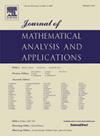通过均质化解决抛物线多尺度逆问题:数值方法
IF 1.2
3区 数学
Q1 MATHEMATICS
Journal of Mathematical Analysis and Applications
Pub Date : 2024-11-22
DOI:10.1016/j.jmaa.2024.129073
引用次数: 0
摘要
我们研究了一种基于均质化的多尺度逆问题求解方法。我们考虑了一类具有在微观尺度上变化的高度振荡张量的抛物线问题。我们假设微观结构已知,并寻求恢复多尺度张量的宏观标量参数化。有限元法等经典方法需要将直接问题的网格解析到最细微的尺度,这可能会导致实施时的计算困难。因此,我们从完整的精细尺度模型出发,从理论和数值两方面解决了通过均质化获得的粗模型的逆问题。输入数据包括通量的测量值和给定时间内直接问题的解,完全基于原始的精细模型。在精细尺度模型的一些自然条件下,确定了通过均质化获得的逆问题的唯一性和稳定性,并通过 G 收敛建立了与后一模型的联系。证明了该方法的误差估计值。本文章由计算机程序翻译,如有差异,请以英文原文为准。
A parabolic multiscale inverse problem approached via homogenization: A numerical method
A method based on homogenization is studied for the solution of a multiscale inverse problem. We consider a class of parabolic problems with highly oscillatory tensors that vary on a microscopic scale. We assume that the microscopic structure is known and seek to recover a macroscopic scalar parameterization of the multiscale tensor. Classical approaches, such as finite elements methods, would require mesh resolution for the direct problem down to the finest scale, that could lead to computational difficulties when implemented. So, starting from the full fine scale model, we solve the inverse problem for a coarse model obtained by homogenization, both theoretically and numerically. The input data, which consist on measurements from the fluxes and the solutions of the direct problem in a given time, are solely based on the original fine scale model. Uniqueness and stability of the inverse problem obtained via homogenization are established under some natural conditions for the fine scale model, and a link with this latter model is established by means of G-convergence. Error estimates are proven for the method.
求助全文
通过发布文献求助,成功后即可免费获取论文全文。
去求助
来源期刊
CiteScore
2.50
自引率
7.70%
发文量
790
审稿时长
6 months
期刊介绍:
The Journal of Mathematical Analysis and Applications presents papers that treat mathematical analysis and its numerous applications. The journal emphasizes articles devoted to the mathematical treatment of questions arising in physics, chemistry, biology, and engineering, particularly those that stress analytical aspects and novel problems and their solutions.
Papers are sought which employ one or more of the following areas of classical analysis:
• Analytic number theory
• Functional analysis and operator theory
• Real and harmonic analysis
• Complex analysis
• Numerical analysis
• Applied mathematics
• Partial differential equations
• Dynamical systems
• Control and Optimization
• Probability
• Mathematical biology
• Combinatorics
• Mathematical physics.

 求助内容:
求助内容: 应助结果提醒方式:
应助结果提醒方式:


